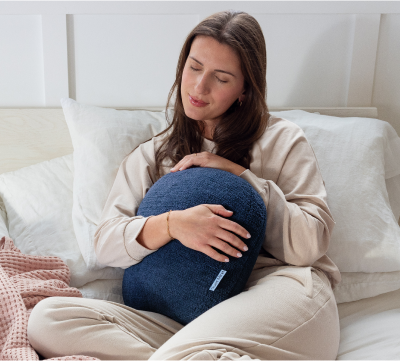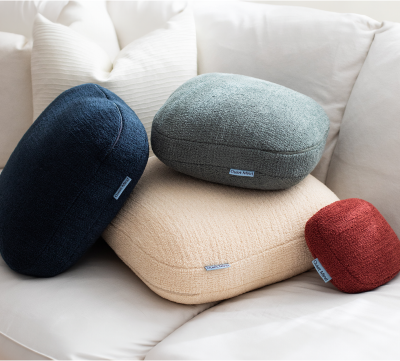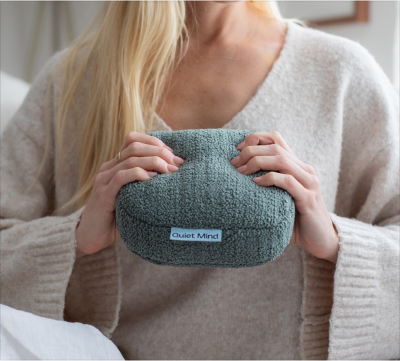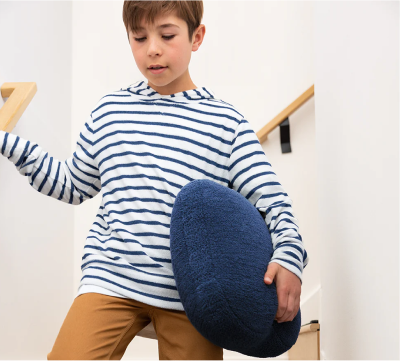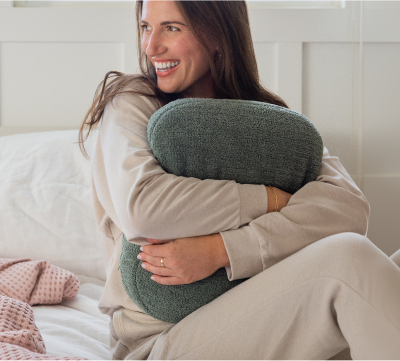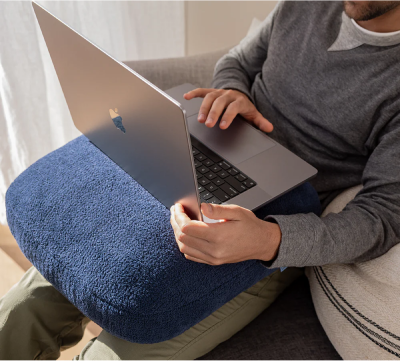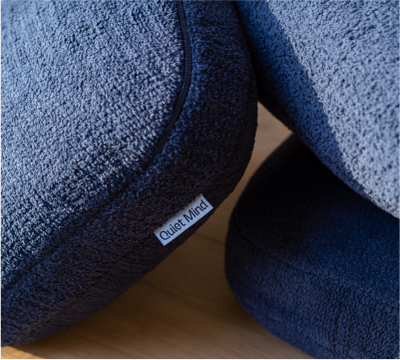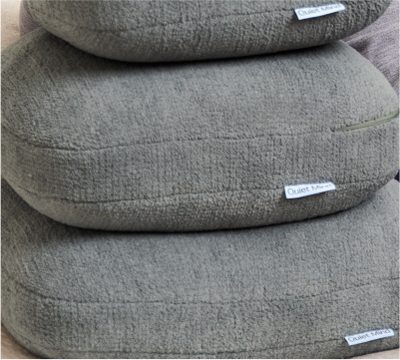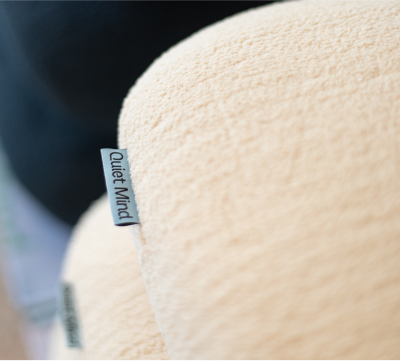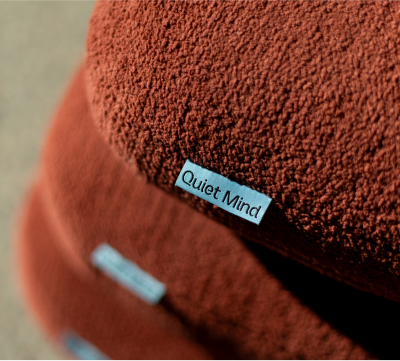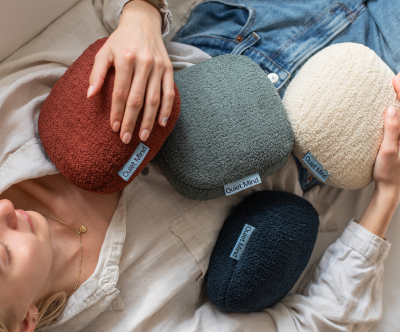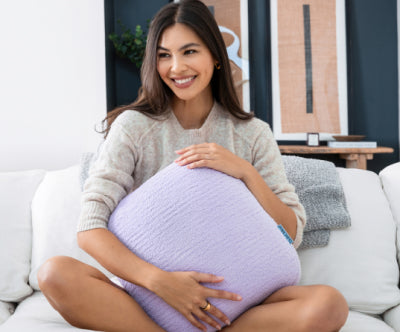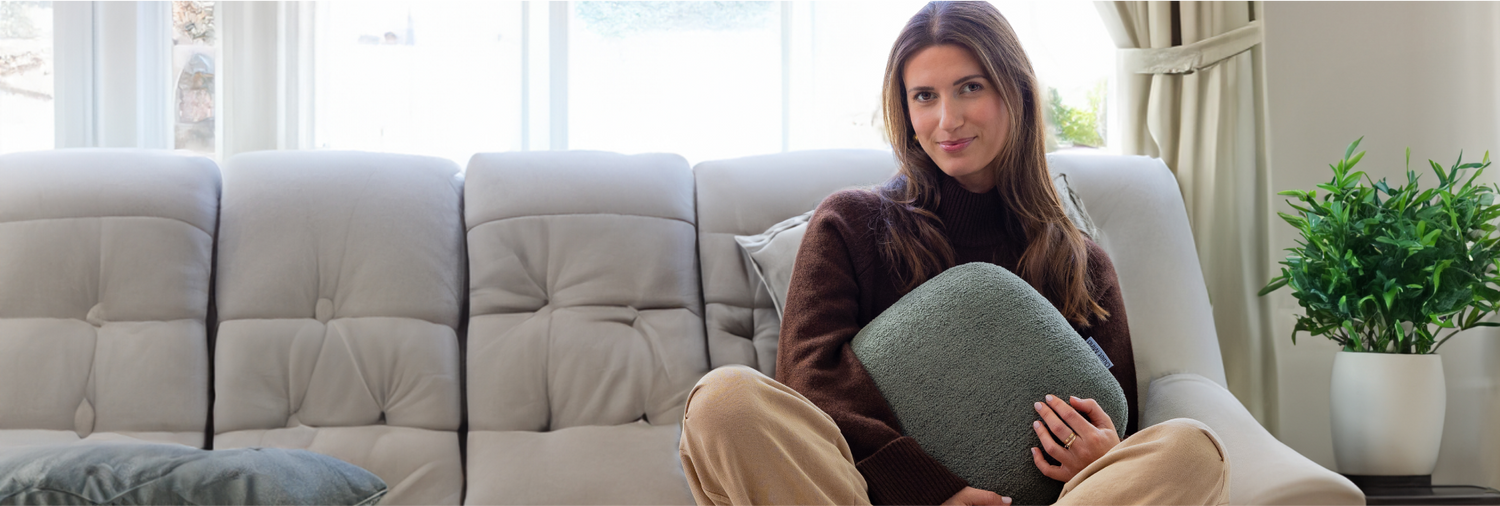Do you find yourself tossing and turning at night, unable to shake the relentless urge to move your legs? Using a weighted pillow or weighted blanket for restless legs can calm your nervous system and your mind to help you sleep better!
Restless Leg Syndrome, or RLS, is a nervous system condition characterized by an overwhelming urge to move your legs. RLS can also be classified as a sleep disorder because it tends to worsen at night, making it difficult to get a good night’s sleep and leaving you feeling depleted and drained in the morning.
The impacts vary from person to person, with some experiencing the symptoms of RLS only occasionally and others on a daily basis. It affects both genders but is more common in women. Let’s explore how a weighted pillow or blanket can provide Deep Pressure Stimulation (DPS) to reduce the symptoms of restless leg syndrome and improve your quality of life.
Restless Legs Symptoms

Do Weighted Blankets Help with Restless Leg Syndrome?
Yes, a weighted blanket or pillow can be remarkably effective in alleviating the symptoms of Restless Leg Syndrome. These simple devices provide a form of Deep Touch Pressure Therapy (DPT) by applying gentle pressure. This technique mimics the effects of a hug and activates feel-good hormones like dopamine and serotonin to help your body and mind relax.
How Weighted Blankets and Weighted Pillows Calm Restless Legs
Using a weighted blanket or pillow for restless legs can help calm the nervous system, reducing involuntary movement and uncomfortable sensations associated with RLS. Weighted pillows or blankets can also help with RLS indirectly by improving sleep quality and overall mental health.
Let’s explore the benefits of a weighted pillow or blanket for RLS more deeply to help you understand how DTP can improve your quality of life with RLS:
Deep Touch Pressure Therapy
Deep Touch Pressure works for RLS by applying gentle pressure through the use of a weighted pillow or blanket. It stimulates the release of serotonin and dopamine. These “feel-good” hormones counteract the stress hormone cortisol, helping your body to relax more effectively.
While DPT has been gaining mainstream popularity recently, it’s actually been used by occupational therapists for decades to help children with autism, ADHD, and other sensory processing disorders. It helps to relax muscles, calm nerves, and encourage stillness in the mind.
Increased Melatonin and Serotonin Production
Through the science of deep touch pressure, the brain associates the feeling of a weighted pillow or blanket with being hugged. This feeling promotes the release of melatonin - the sleep hormone, and serotonin - the happy hormone. These hormones help to quiet your mind, helping you fall asleep more easily, sleep more deeply, and stay asleep longer.
Improved Sleep Quality
For some sufferers, RLS can affect mental health just as much as physical health. RLS can contribute to sleep deprivation by causing discomfort and pain, insomnia, and the irresistible urge to get up and walk around.
Over time, the brain may even begin to associate bedtime with discomfort, stress, and anxiety. For many, anxiety about the night ahead starts long before the physical symptoms of RLS even kick in.
The soothing pressure of a weighted blanket or pillow allows the body to switch from the “fight or flight” response of the Sympathetic Nervous System to the “rest and digest” response of the Parasympathetic Nervous System. This shift allows the mind and body to switch gears so you can relax and fall asleep more easily.
Reduced Cortisol Levels
Elevated levels of cortisol, the stress hormone, have been linked to RLS. Cortisol can trigger feelings of anxiety and stress or worsen existing symptoms. Weighted blankets and pillows counteract these effects by lowering cortisol levels and providing a grounding sensation throughout the night as you sleep, further combatting stress, anxiety, and sleep dysfunction.
Reduced Twitching, Kicking, and Movement
One of the most difficult symptoms of RLS is the involuntary limb twitching, kicking, and movement that disrupts sleep. These movements can easily wake you up, forcing you to start the process all over again.
The calming effects of DTP on the muscles and nervous system reduce Periodic Limb Movements (PLM) so you can sleep more deeply for longer periods of time.
Understanding Restless Leg Syndrome
Let’s delve into the symptoms, causes, and risk factors behind RLS to help you find relief naturally.
Symptoms of Restless Legs Syndrome
The symptoms of Restless Leg Syndrome can vary from mild to severe. For some, they disrupt both sleep and daily activities on a regular basis; for others, they only appear occasionally. The most common symptoms of RLS include:
- An overwhelming urge to move the legs.
- Involuntary movements of the legs and arms during sleep.
- Sensations of crawling, tingling, or creeping in the limbs.
- Discomfort or restlessness primarily in the legs but can also occur in the arms, hands, and feet.
- Temporary relief of symptoms through movement or stretching.
- Symptoms often worsen during periods of inactivity, such as prolonged sitting or lying down.
Causes and Risk Factors for Restless Legs Syndrome
Restless Leg Syndrome presents in two forms: primary or secondary. Primary RLS is the most common and is thought to be genetic. Doctors are unable to determine the precise cause of primary RLS, but it’s thought to be related to levels of dopamine in the body.
Primary RLS responds well to Deep Touch Pressure Therapy, such as that provided by a weighted pillow. Warm baths, leg massages, ice packs applied to the legs, regular exercise, and prioritizing quality sleep can also help relieve the symptoms of RLS naturally at home.
On the other hand, RLS that occurs as the result of a health condition is classified as secondary RLS. This type of RLS may occur in individuals with chronic health conditions like anemia and iron deficiency, fibromyalgia, kidney disease, or diabetes. It can also occur during pregnancy.
Secondary RLS can also be triggered by certain medications, stress, or even an unhealthy lifestyle. For individuals with secondary RLS, the symptoms usually disappear or improve once the underlying condition is treated or resolved. In the meantime, DTP and a healthy lifestyle can relieve unpleasant symptoms.
Choosing the Best Weighted Pillow or Weighted Blanket for Restless Legs Syndrome
-
Weight: To ensure optimal benefits, opt for a weighted pillow or blanket that is approximately 10% or less of your body weight. Our huggable weighted pillow is available in three weights, ranging from 6 to 12 pounds, ensuring safety and comfort for all users.
- Size: Choose a size that feels comfortable to you. The Original Weighted Pillow by Quiet Mind comes in three sizes to accommodate a wide range of users.
- Material: Look for breathable and hypoallergenic materials to prevent overheating or skin irritation. The Original Weighted Pillow is crafted from eco-friendly recycled glass beads and includes a machine-washable cover.
- Versatility: If you’re looking for the most versatile option, consider a weighted pillow. Weighted pillows are compact and portable, so they can be used anywhere and in a wide variety of positions to help you manage RLS symptoms.
How to Use a Weighted Pillow for Restless Legs
Weighted pillows and blankets offer effective solutions for managing Restless Legg Syndrome (RLS). While weighted blankets provide full-body coverage, they can be cumbersome and are not for everyone. Weighted pillows, on the other hand, offer targeted relief and convenience.
A weighted pillow can be positioned between the knees or on the calves or thighs to provide targeted relief. Place it in your lap when watching TV, or use it as a lap desk to provide the benefits of DTP anywhere you go.
We suggest incorporating a weighted pillow into your daily routine and using it consistently to maximize the benefits. Combining it with a healthy lifestyle will amplify the benefits and help you find greater relief.
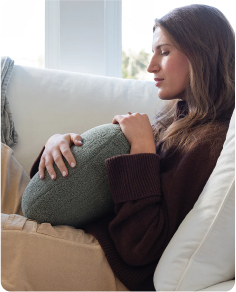
- Dara O
Who Should Not Use a Weighted Blanket for Restless Legs?
While weighted blankets offer therapeutic benefits, they may not be suitable for everyone. Weighted blankets should never be used by infants, young children, or individuals with cognitive impairments or physical limitations that may prevent them from removing the blanket independently.
People with chronic back pain, respiratory or circulatory conditions, and claustrophobia should also exercise caution when using weighted blankets. Weighted blankets can trap heat close to the body while you sleep, so they aren’t the best solution for hot sleepers or those with health conditions that leave them prone to overheating.
Relieve the Symptoms of RLS with a Weighted Pillow
By understanding the symptoms, causes, and management strategies of Restless Leg Syndrome, users can find relief from discomfort, improve sleep quality, and enhance overall well-being.
Consider the Original Weighted Pillow by Quiet Mind for a personalized solution for restless legs. Crafted with premium materials and an innovative design, our weighted pillow offers targeted relief for those struggling with the relentless sensations of RLS.
